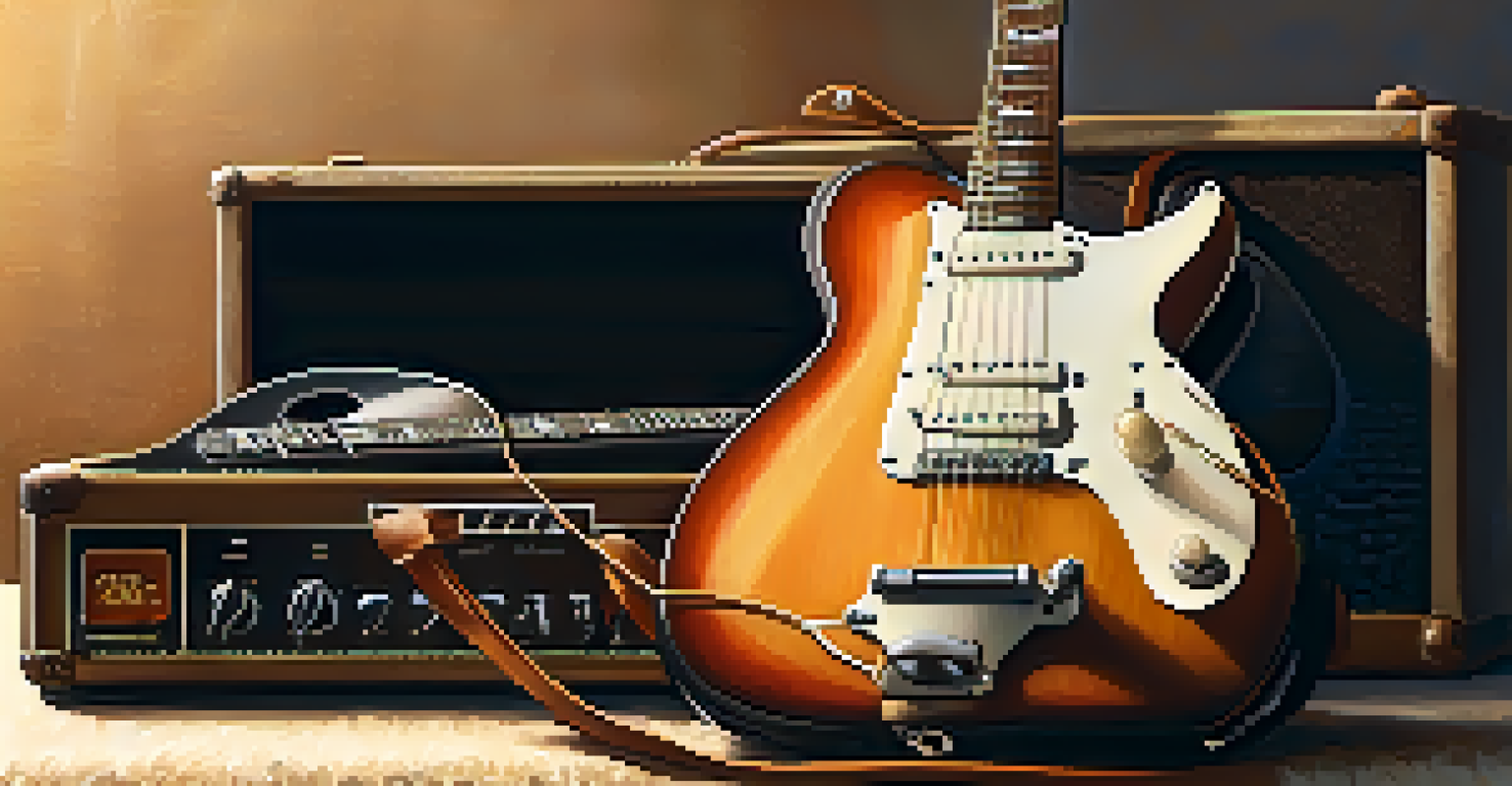Guitar Setup Basics: Ensuring Your New Guitar Plays Well

Understanding Guitar Setup: Why It Matters
When you first get your guitar, it may not play as well as you expect. This is where understanding guitar setup comes in. A proper setup ensures that your instrument feels comfortable and sounds great, making it easier for you to express yourself musically.
The guitar is a miniature orchestra in itself.
Think of your guitar like a car; if it’s not tuned properly or aligned, it won't drive smoothly. Similarly, a well-set-up guitar allows for better intonation, action, and playability, which can significantly enhance your playing experience.
By investing a little time in setup, you can avoid frustration and unlock your guitar's full potential. Whether you're a beginner or an experienced player, a good setup can make a world of difference.
Checking the Neck Relief: A Key Step
Neck relief refers to the slight curve in your guitar's neck that allows strings to vibrate freely. To check this, press down on the first and last frets of the low E string and observe the gap at the 8th fret. Ideally, there should be a small gap—about the thickness of a business card.

If the gap is too large, your strings may feel too high, making them difficult to play. Conversely, if there’s no gap, you might experience buzzing when you play. Adjusting the truss rod can correct these issues, but be careful; small adjustments can make a big difference.
Importance of Guitar Setup
A proper guitar setup enhances playability and sound quality, allowing musicians to express themselves more effectively.
Finding the right neck relief is essential for comfortable playability. Taking the time to adjust this can help you avoid unnecessary strain on your fingers.
Setting the Action: Playability at Its Best
Action refers to the height of your strings above the fretboard. If your action is too high, you'll be putting in more effort to press down on the strings, which can be tiring, especially during long jam sessions. On the other hand, if it's too low, you might experience fret buzz.
It’s not the guitar that makes the music; it’s the player.
To set the action, measure the distance from the bottom of the strings to the top of the frets. Most players prefer an action that balances comfort and tone, generally between 1.5mm to 2.5mm for electric guitars. Adjusting the saddles on your bridge can help you achieve the right height.
Finding your ideal action is like tailoring a suit; it should fit you perfectly. A well-set action enhances your playing style and can even improve your tone.
Intonation: Keeping Your Guitar in Tune
Intonation is the adjustment that ensures your guitar plays in tune along the entire fretboard. If your guitar sounds good open but goes sharp or flat as you play higher up, it’s time to check the intonation. This involves adjusting the length of the strings at the bridge.
To check intonation, play the 12th fret harmonic and compare it to the fretted note at the same fret. If they don’t match, adjustments are necessary. Moving the saddle forward or backward can help you achieve perfect intonation, leading to a more harmonious sound.
Key Setup Adjustments
Adjustments like neck relief, action, and intonation are crucial for comfort and ensuring your guitar stays in tune across the fretboard.
Good intonation means your guitar will sound great no matter where you are on the neck. It’s like having a perfectly tuned piano; every note should resonate beautifully.
Pickup Height: Finding Your Sweet Spot
Pickup height can significantly affect your guitar's tone and volume. If your pickups are too close to the strings, they can create a harsh sound or cause unwanted feedback. Conversely, if they’re too far away, you may lose clarity and volume.
To find the right height, press down on the last fret and check the distance between the pickup and the string. A good starting point is about 2mm to 3mm for single-coil pickups and slightly more for humbuckers. Adjust the pickup screws to find that sweet spot.
When your pickups are at the right height, you'll notice a fuller sound and better dynamics. It’s all about balance, ensuring you can express every nuance of your playing.
String Selection: Finding Your Voice
Choosing the right strings for your guitar is crucial for both playability and tone. Strings come in various gauges, which affects tension and feel. Lighter gauge strings are easier to play but may sacrifice some tone, while heavier strings can provide a richer sound at the cost of playability.
Consider what style of music you play and how you like your guitar to feel. If you’re strumming chords, lighter strings might be your best bet, while heavier strings can offer depth for soloing. Experimenting with different brands and gauges can help you discover your perfect match.
Regular Maintenance is Essential
Consistent care and maintenance keep your guitar in top shape, prolonging its life and improving your overall playing experience.
The right strings can greatly enhance your overall experience, letting you connect with your instrument on a deeper level. Remember, your guitar is an extension of your musical voice!
Regular Maintenance: Keeping Your Guitar in Top Shape
Once your guitar is set up, regular maintenance is key to keeping it in great playing condition. This includes cleaning the fretboard, changing strings, and checking for any issues like fret wear or hardware looseness. A little care goes a long way in prolonging your guitar’s life.
Consider using a soft cloth to wipe down your strings after each use, which helps prevent corrosion. Additionally, schedule a professional setup at least once a year to address any issues you might miss during regular play.

Just like maintaining a garden, consistent care can help your guitar flourish. A well-maintained instrument will not only sound better, but it will also inspire you to play more!